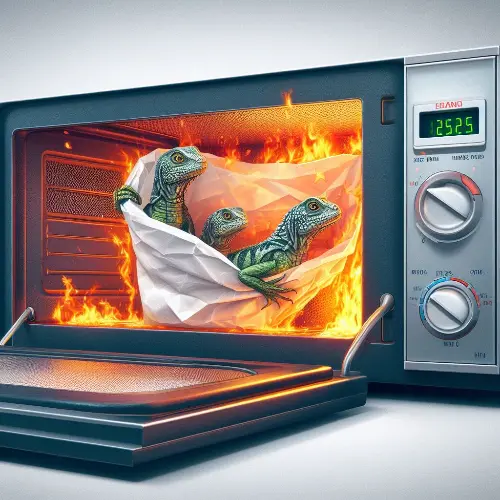Thekitchenkits.online is an Amazon Associate and earns from qualifying purchases made through affiliate links on our site at no extra cost to you. This supports our efforts to bring you valuable kitchen-related content.
Table of Contents
Can You Microwave Freezer Paper?
Freezer paper is a tool commonly used in the kitchen for wrapping and storing food in the freezer. But can you microwave freezer paper? The short answer is no, and freezer paper should not be microwaved.
What is Freezer Paper?
Freezer paper is a heavy-duty paper coated on one side with a thin layer of plastic or wax. This coating acts as a barrier against air and moisture when wrapping food. The purpose of freezer paper is to help prevent freezer burn and spoilage when freezing food items.
The plastic or wax coating makes freezer paper non-stick. This lets you wrap food tightly before storing it in the freezer. The tight wrap helps limit exposure to air, which is the primary cause of freezer burn.
Freezer paper is thicker and more robust than regular paper. It is also more durable than aluminum foil when used for freezing. The extra thickness and strength allow freezer paper to tightly wrap food without ripping.
Freezer Paper vs. Parchment Paper
It’s essential to distinguish freezer paper from parchment paper. While they are both coated papers used for food storage, there are some key differences:
- Freezer paper – Has a plastic or wax coating on one side. They are used for freezing meats and other foods. Not heat resistant.
- Parchment paper – Has a silicone coating on both sides. They are used for baking. It is heat resistant.
Parchment paper is treated to withstand high temperatures, so it can be used for baking or roasting in the oven. Freezer paper is not designed to withstand high heat.
Freezer Paper in the Microwave
Freezer paper should never be microwaved. The plastic or wax coating will likely melt in the microwave, causing a mess. The coating could also leach chemicals into your food, which you do not want.
Microwaves generate intense internal heat very quickly. The wax coating on freezer paper will melt at temperatures above 130°F to 140°F. Well below most microwaving temperatures.
If you try to microwave freezer paper, the wax will liquefy and destroy the paper’s integrity. It could also leak onto your food or plate.
Instead of freezer paper, use microwave-safe materials like parchment paper, wax paper, paper towels, or plastic wrap when reheating foods. Do not rely on freezer paper to withstand microwave heat.
Proper Uses for Freezer Paper
While freezer paper should not go in the microwave, here are the recommended uses:
- Wrapping meats, fish, and poultry for the freezer
- Making freezer meal packets
- Freezing casseroles, baked goods, and leftovers
- Lining pans when baking meatloaves or lasagnas to freeze
- Craft projects like stenciling and applique
Freezer paper is ideal for protecting foods in the freezer thanks to its moisture-resistant coating. Before reheating anything wrapped in freezer paper, you move frozen foods into microwave-safe containers.
Freezer Paper Coating and Wax Paper Differences
The coating found on freezer paper makes it very similar to wax paper. But they are designed for different uses.
Here’s how freezer paper and wax paper differ:
- Freezer paper coating – Made of thin plastic or wax to prevent freezer burn and not meant for high heat.
- Wax paper coating – Made of wax to create a non-stick surface. It has a lower melting point to be used for cooking.
- Strength – Freezer paper is more potent and thicker. Wax paper is fragile and delicate.
- Sides coated – Freezer paper only has a coating on one side. Wax paper has a coating on both sides.
- Uses – Freezer paper for wrapping frozen foods—wax paper for cooking and covering food.
So, wax paper has a different type of wax coating that allows it to be heated in the oven or microwave. You can use wax paper when reheating frozen items wrapped in freezer paper.
FAQs
Can freezer paper go in the microwave?
No, freezer paper cannot be used in the microwave. This is because the freezer paper has a plastic coating on one side that can melt under the heat generated by the microwave, causing a potential fire risk.
What is the use of freezer paper?
Freezer paper is primarily for storing and protecting food in the freezer against freezer burn. The plastic coating on one side of the report helps to lock in the freshness and prevents the food from drying out. It can also be used for wrapping items like sandwiches for storage or consumption later.
Can freezer paper go in the oven?
Freezer paper cannot go in the oven due to the plastic coating on one side. The plastic can melt at high temperatures in a range, posing health risks and a potential fire hazard. Instead, one should use parchment or baking paper, which is heat-resistant and safe for oven use.
What is the difference between butcher paper and freezer paper?
Butcher paper is a type of thick paper used for wrapping meat in butcher shops, while freezer paper is a special kind of paper with a plastic coating designed explicitly for preserving food in the freezer. Butcher paper has no plastic layer; therefore, unlike freezer paper, it can be used in the oven.
How does freezer paper prevent freezer burn?
The plastic coating on one side of the freezer paper helps seal moisture, preventing the food from drying out when stored in the freezer for extended periods. This is how freezer paper helps to prevent freezer burn.
Can butcher paper go in the oven?
Yes, butcher paper can be used in the oven. Unlike freezer paper, it doesn’t have a plastic coating, so it is safe to use at high temperatures. This makes it suitable for oven use.
Can you substitute freezer paper with parchment paper or baking paper?
Freezer paper can be substituted with parchment paper or baking paper, but only for non-freezing applications. Unlike freezer paper, parchment, and baking pieces are heat-resistant and thus safe for use in the oven. However, they might not prevent freezer burn as effectively as freezer paper when used in the freezer.
Are there different types of freezer paper?
There are not typically different types of freezer paper. Standard freezer paper usually has a plastic coating on one side and a report on the other. However, based on usage requirements, freezer paper can come in different thicknesses and sizes.
How do you identify the plastic-coated side of the freezer paper?
The plastic-coated side of the freezer paper is usually glossier and slightly smoother than the paper side. Also, the plastic side is typically the inside of the roll when purchased.
Is freezer paper juice resistant?
Yes, the plastic coating on the freezer paper makes it resistant to liquids like juices. This property makes it ideal for wrapping items that release juice, such as fresh fruits or raw meat.
Key Takeaways
- Freezer paper has a plastic or wax coating that prevents freezer burn when freezing foods. It is not meant for heating or microwaving.
- Never microwave freezer paper – the coating can melt, damage the article, and possibly contaminate your food.
- Use microwave-safe materials like parchment paper or wax paper to reheat frozen foods.
- Freezer paper is only intended for cold-temperature food storage in the freezer. Always repackage frozen items wrapped in freezer paper before reheating.
- Parchment paper is the right choice for baking and microwaving thanks to its silicone coating that can withstand high heat.
In summary, freezer paper and parchment paper serve different roles. Freezer paper protects food in the freezer but should never go in the microwave.
For reheating foods safely, use microwave-safe parchment paper instead. Check your report and only use freezer paper for its intended purpose of freezing foods.

I’m Ian Welkins, a seasoned professional in the kitchen industry. My passion now drives me to provide invaluable insights into the world of top-notch kitchen products. With years of hands-on experience, I’m your go-to source for culinary excellence.


